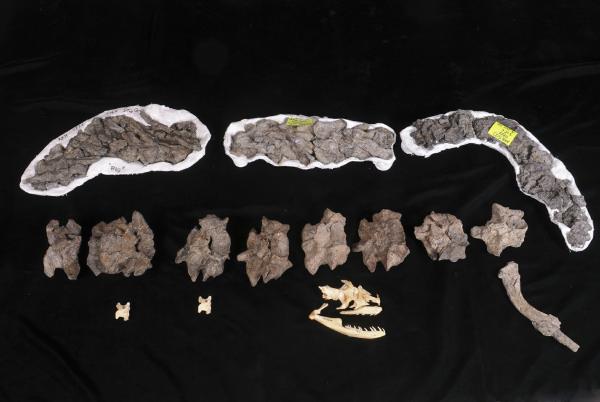An ancient crocodile relative, a dyrosaurid now named Acherontisuchus guajiraensis, likely gave the world's largest snake a tussle or two. In Palaeontology, University of Florida researchers describe the new 20-foot extinct species which was discovered in the same Colombian coal mine as Titanoboa cerrejonensis, the world's largest snake.
Since Acherontisuchus was a freshwater, coastal reptile, it ate fish and therefore competed with Titanoboa in the Paleocene New World tropics 60-million-years ago. Prior to this, it was believed that a dyrosaurid only entered freshwater as a baby and returned to the ocean when it was older. The new finding disputes that.

This photograph shows the size difference in the jawbones of two 60-million-year-old crocodile ancestors found in northeastern Colombia by University of Florida researchers. Acherontisuchus guajiraensis in on top. The other specimen, Cerrejonisuchus improcerus, was the first ancient crocodyliform found in the Cerrejon open-pit coal mine. The new species is the first known land animal from the Paleocene New World tropics specialized for eating fish, putting it in competition with Titanoboa, the world’s largest snake. Florida Museum of Natural History photo taken Sept. 1, 2011 by Kristen Grace
The same food and the same habitat means they could also have gone after each other. A 40-foot snake versus a 20-foot crocodile? I'd watch that movie.
The fossils of the partial skeleton of Acherontisuchus guajiraensis were the second ancient crocodyliform found in the Cerrejon mine of northern Colombia, one of the world's largest open-pit coal mines (see 60-Million-Year-Old Crocodile Ancestor Was Snake Food for the first one). The genus is named for the Acheron river of Greek mythology, "the river of woe" and a branch of the underworld river Styx. The researchers say that genus name was chosen because the animal lived in a wide river that emptied into the Caribbean.
The snout of the new species was long, narrow and full of pointed teeth, so it likely hunted relatives of bonefish that inhabited the water. During the Paleocene in South America, reptiles ruled so this relative to modern crocodiles was in a world full of giant snakes and turtles. Researchers believe the dyrosaurid family originated in Africa around 75 million years ago and arrived in South America by swimming across the Atlantic Ocean.

A display of vertebra and rib bones from the Titanboa, which grew up to 45 feet, weighed 1.25 tons and was the largest vertebrate on earth for 20 million years. On the bottom center are the vertebra and skull of a modern 17 foot Anaconda for size comparison. Photo: Ray Carson UF News Bureau
What about gigantic reptile battles? Who would have won?

What we are all curious about. Titanoboa versus Acherontisuchus. Florida Museum of Natural History illustration by Danielle Byerley
"The younger individuals were definitely not safe from Titanoboa, but the biggest of these species would have been a bit much for the 42-foot snake to handle," said lead author Alex Hastings, a graduate student at the Florida Museum of Natural History and University of Florida's department of geological sciences. "The same thing that snuffed out the dinosaurs killed off most of the crocodiles alive at the time. The dyrosaurids are one of the few groups to survive the extinction and later become more successful."

Debbie Gibson lent "Mega Shark Versus Giant Octopus" its authenticity. Really, she is the only thing that could make the Acherontisuchus V. Titanoboa movie better.
Citation:ALEXANDER K. HASTINGS, JONATHAN I. BLOCH and CARLOS A. JARAMILLO, 'A new longirostrine dyrosaurid (Crocodylomorpha, Mesoeucrocodylia) from the Paleocene of north-eastern Colombia: biogeographic and behavioural implications for New-World Dyrosauridae', Palaeontology, Article first published online: 15 SEP 2011 DOI: 10.1111/j.1475-4983.2011.01092.x



Comments